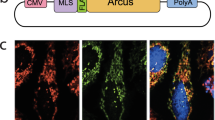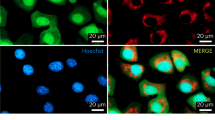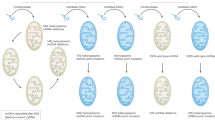Abstract
The ability to manipulate mitochondrial DNA (mtDNA) heteroplasmy would provide a powerful tool to treat mitochondrial diseases. Recent studies showed that mitochondria-targeted restriction endonucleases can modify mtDNA heteroplasmy in a predictable and efficient manner if it recognizes a single site in the mutant mtDNA. However, the applicability of such model is limited to mutations that create a novel cleavage site, not present in the wild-type mtDNA. We attempted to extend this approach to a ‘differential multiple cleavage site’ model, where an mtDNA mutation creates an extra restriction site to the ones normally present in the wild-type mtDNA. Taking advantage of a heteroplasmic mouse model harboring two haplotypes of mtDNA (NZB/BALB) and using adenovirus as a gene vector, we delivered a mitochondria-targeted Scal restriction endonuclease to different mouse tissues. Scal recognizes five sites in the NZB mtDNA but only three in BALB mtDNA. Our results showed that changes in mtDNA heteroplasmy were obtained by the expression of mitochondria-targeted ScaI in both liver, after intravenous injection, and in skeletal muscle, after intramuscular injection. Although mtDNA depletion was an undesirable side effect, our data suggest that under a regulated expression system, mtDNA depletion could be minimized and restriction endonucleases recognizing multiple sites could have a potential for therapeutic use.
This is a preview of subscription content, access via your institution
Access options
Subscribe to this journal
Receive 12 print issues and online access
$259.00 per year
only $21.58 per issue
Buy this article
- Purchase on Springer Link
- Instant access to full article PDF
Prices may be subject to local taxes which are calculated during checkout






Similar content being viewed by others
References
Schaefer AM, Taylor RW, Turnbull DM, Chinnery PF . The epidemiology of mitochondrial disorders – past, present and future. Biochim Biophys Acta 2004; 1659: 115–120.
Chinnery PF, Johnson MA, Wardell TM, Singh-Kler R, Hayes C, Brown DT et al. The epidemiology of pathogenic mitochondrial DNA mutations. Ann Neurol 2000; 48: 188–193.
Solignac M, Monnerot M, Mounolou JC . Mitochondrial DNA heteroplasmy in Drosophila mauritiana. Proc Natl Acad Sci USA 1983; 80: 6942–6946.
Chomyn A, Martinuzzi A, Yoneda M, Daga A, Hurko O, Johns D et al. MELAS mutation in mtDNA binding site for transcription termination factor causes defects in protein synthesis and in respiration but no change in levels of upstream and downstream mature transcripts. Proc Natl Acad Sci USA 1992; 89: 4221–4225.
Hanna MG, Nelson IP, Morgan-Hughes JA, Harding AE . Impaired mitochondrial translation in human myoblasts harbouring the mitochondrial DNA tRNA lysine 8344 A → G (MERRF) mutation: relationship to proportion of mutant mitochondrial DNA. J Neurol Sci 1995; 130: 154–160.
Taivassalo T, Fu K, Johns T, Arnold D, Karpati G, Shoubridge EA . Gene shifting: a novel therapy for mitochondrial myopathy. Hum Mol Genet 1999; 8: 1047–1052.
Shoubridge EA, Johns T, Karpati G . Complete restoration of a wild-type mtDNA genotype in regenerating muscle fibres in a patient with a tRNA point mutation and mitochondrial encephalomyopathy. Hum Mol Genet 1997; 6: 2239–2242.
Clark KM, Bindoff LA, Lightowlers RN, Andrews RM, Griffiths PG, Johnson MA et al. Reversal of a mitochondrial DNA defect in human skeletal muscle. Nat Genet 1997; 16: 222–224.
Manfredi G, Gupta N, Vazquez-Memije ME, Sadlock JE, Spinazzola A, De Vivo DC et al. Oligomycin induces a decrease in the cellular content of a pathogenic mutation in the human mitochondrial ATPase 6 gene. J Biol Chem 1999; 274: 9386–9391.
Taylor RW, Chinnery PF, Turnbull DM, Lightowlers RN . Selective inhibition of mutant human mitochondrial DNA replication in vitro by peptide nucleic acids. Nat Genet 1997; 15: 212–215.
Chinnery PF, Taylor RW, Diekert K, Lill R, Turnbull DM, Lightowlers RN . Peptide nucleic acid delivery to human mitochondria. Gene Therapy 1999; 6: 1919–1928.
Tang Y, Schon EA, Wilichowski E, Vazquez-Memije ME, Davidson E, King MP . Rearrangements of human mitochondrial DNA (mtDNA): new insights into the regulation of mtDNA copy number and gene expression. Mol Biol Cell 2000; 11: 1471–1485.
Cazzalini O, Lazze MC, Iamele L, Stivala LA, Bianchi L, Vaghi P et al. Early effects of AZT on mitochondrial functions in the absence of mitochondrial DNA depletion in rat myotubes. Biochem Pharmacol 2001; 62: 893–902.
Jazayeri M, Andreyev A, Will Y, Ward M, Anderson CM, Clevenger W . Inducible expression of a dominant negative DNA polymerase-gamma depletes mitochondrial DNA and produces a rho0 phenotype. J Biol Chem 2003; 278: 9823–9830.
Bayona-Bafaluy MP, Blits B, Battersby BJ, Shoubridge EA, Moraes CT . Rapid directional shift of mitochondrial DNA heteroplasmy in animal tissues by a mitochondrially targeted restriction endonuclease. Proc Natl Acad Sci USA 2005; 102: 14392–14397.
Srivastava S, Moraes CT . Manipulating mitochondrial DNA heteroplasmy by a mitochondrially targeted restriction endonuclease. Hum Mol Genet 2001; 10: 3093–3099.
Tanaka M, Borgeld HJ, Zhang J, Muramatsu S, Gong JS, Yoneda M et al. Gene therapy for mitochondrial disease by delivering restriction endonuclease SmaI into mitochondria. J Biomed Sci 2002; 9: 534–541.
Huard J, Lochmuller H, Acsadi G, Jani A, Massie B, Karpati G . The route of administration is a major determinant of the transduction efficiency of rat tissues by adenoviral recombinants. Gene Therapy 1995; 2: 107–115.
Sullivan DE, Dash S, Du H, Hiramatsu N, Aydin F, Kolls J et al. Liver-directed gene transfer in non-human primates. Hum Gene Ther 1997; 8: 1195–1206.
Jenuth JP, Peterson AC, Shoubridge EA . Tissue-specific selection for different mtDNA genotypes in heteroplasmic mice. Nat Genet 1997; 16: 93–95.
Moraes CT, Shanske S, Tritschler HJ, Aprille JR, Andreetta F, Bonilla E et al. mtDNA depletion with variable tissue expression: a novel genetic abnormality in mitochondrial diseases. Am J Hum Genet 1991; 48: 492–501.
Reichmann H . Enzyme activity analyses along ragged-red and normal single muscle fibres. Histochemistry 1992; 98: 131–134.
D'Souza GG, Weissig V . Approaches to mitochondrial gene therapy. Curr Gene Ther 2004; 4: 317–328.
Bangari DS, Mittal SK . Current strategies and future directions for eluding adenoviral vector immunity. Curr Gene Ther 2006; 6: 215–226.
Cao H, Koehler DR, Hu J . Adenoviral vectors for gene replacement therapy. Viral Immunol 2004; 17: 327–333.
Shayakhmetov DM, Li ZY, Ni S, Lieber A . Analysis of adenovirus sequestration in the liver, transduction of hepatic cells, and innate toxicity after injection of fiber-modified vectors. J Virol 2004; 78: 5368–5381.
Everett RS, Hodges BL, Ding EY, Xu F, Serra D, Amalfitano A . Liver toxicities typically induced by first-generation adenoviral vectors can be reduced by use of E1, E2b-deleted adenoviral vectors. Hum Gene Ther 2003; 14: 1715–1726.
Nicklin SA, Wu E, Nemerow GR, Baker AH . The influence of adenovirus fiber structure and function on vector development for gene therapy. Mol Ther 2005; 12: 384–393.
Xu ZL, Mizuguchi H, Sakurai F, Koizumi N, Hosono T, Kawabata K et al. Approaches to improving the kinetics of adenovirus-delivered genes and gene products. Adv Drug Deliv Rev 2005; 57: 781–802.
Battersby BJ, Shoubridge EA . Selection of a mtDNA sequence variant in hepatocytes of heteroplasmic mice is not due to differences in respiratory chain function or efficiency of replication. Hum Mol Genet 2001; 10: 2469–2479.
Moreno-Loshuertos R, Acin-Perez R, Fernandez-Silva P, Movilla N, Perez-Martos A, Rodriguez de Cordoba S et al. Differences in reactive oxygen species production explain the phenotypes associated with common mouse mitochondrial DNA variants. Nat Genet 2006; 38: 1261–1268.
Dimauro S . Mitochondrial myopathies. Curr Opin Rheumatol 2006; 18: 636–641.
Menezes KM, Mok HS, Barry MA . Increased transduction of skeletal muscle cells by fibroblast growth factor-modified adenoviral vectors. Hum Gene Ther 2006; 17: 314–320.
O'Hara AJ, Howell JM, Taplin RH, Fletcher S, Lloyd F, Kakulas B et al. The spread of transgene expression at the site of gene construct injection. Muscle Nerve 2001; 24: 488–495.
Martin-Touaux E, Puech JP, Chateau D, Emiliani C, Kremer EJ, Raben N et al. Muscle as a putative producer of acid alpha-glucosidase for glycogenosis type II gene therapy. Hum Mol Genet 2002; 11: 1637–1645.
Dudley RW, Lu Y, Gilbert R, Matecki S, Nalbantoglu J, Petrof BJ et al. Sustained improvement of muscle function one year after full-length dystrophin gene transfer into mdx mice by a gutted helper-dependent adenoviral vector. Hum Gene Ther 2004; 15: 145–156.
Allamand V, Donahue KM, Straub V, Davisson RL, Davidson BL, Campbell KP . Early adenovirus-mediated gene transfer effectively prevents muscular dystrophy in alpha-sarcoglycan-deficient mice. Gene Therapy 2000; 7: 1385–1391.
Ragot T, Perricaudet M . [Development of adenoviral vectors in gene therapy: application to gene transfer in muscles]. C R Seances Soc Biol Fil 1996; 190: 13–31.
Mitsuoka T, Kawarai T, Watanabe C, Katayama S, Nakamura S . Comparison of clinical pictures of mitochondrial encephalomyopathy with tRNA(Leu(UUR)) mutation in 3243 with that in 3254]. No To Shinkei 1998; 50: 1089–1092.
Walther W, Arlt F, Fichtner I, Aumann J, Stein U, Schlag PM . Heat-inducible in vivo gene therapy of colon carcinoma by human mdr1 promoter-regulated tumor necrosis factor-alpha expression. Mol Cancer Ther 2007; 6: 236–243.
Gonzalez-Nicolini V, Sanchez-Bustamante CD, Hartenbach S, Fussenegger M . Adenoviral vector platform for transduction of constitutive and regulated tricistronic or triple-transcript transgene expression in mammalian cells and microtissues. J Gene Med 2006; 8: 1208–1222.
Gregorevic P, Allen JM, Minami E, Blankinship MJ, Haraguchi M, Meuse L et al. rAAV6-microdystrophin preserves muscle function and extends lifespan in severely dystrophic mice. Nat Med 2006; 12: 787–789.
Petruzzella V, Moraes CT, Sano MC, Bonilla E, DiMauro S, Schon EA . Extremely high levels of mutant mtDNAs co-localize with cytochrome c oxidase-negative ragged-red fibers in patients harboring a point mutation at nt 3243. Hum Mol Genet 1994; 3: 449–454.
De Giorgi F, Ahmed Z, Bastianutto C, Brini M, Jouaville LS, Marsault R et al. Targeting GFP to organelles. Methods Cell Biol 1999; 58: 75–85.
Moraes CT, Ricci E, Petruzzella V, Shanske S, DiMauro S, Schon EA et al. Molecular analysis of the muscle pathology associated with mitochondrial DNA deletions. Nat Genet 1992; 1: 359–367.
Diaz F, Thomas CK, Garcia S, Hernandez D, Moraes CT . Mice lacking COX10 in skeletal muscle recapitulate the phenotype of progressive mitochondrial myopathies associated with cytochrome c oxidase deficiency. Hum Mol Genet 2005; 14: 2737–2748.
Barrientos A . In vivo and in organello assessment of OXPHOS activities. Methods 2002; 26: 307–316.
Bradford MM . A rapid and sensitive method for the quantitation of microgram quantities of protein utilizing the principle of protein–dye binding. Anal Biochem 1976; 72: 248–254.
Acknowledgements
We are grateful to Dr Alexander Marcillo for assistance with surgical procedures. We are indebted to Brendan Battersby and Eric A Shoubridge for the NZB/BALB heteroplasmic mice and to New England Biolabs for the ScaI construct. We also thank the University of Miami Miller School of Medicine Imaging Core for their assistance. This work was supported by PHS grants EY10804 and NS041777. SB is supported by a supplement to PHS Grant EY10804.
Author information
Authors and Affiliations
Corresponding author
Additional information
Supplementary Information accompanies the paper on Gene Therapy website (http://www.nature.com/gt)
Supplementary information
Rights and permissions
About this article
Cite this article
Bacman, S., Williams, S., Hernandez, D. et al. Modulating mtDNA heteroplasmy by mitochondria-targeted restriction endonucleases in a ‘differential multiple cleavage-site’ model. Gene Ther 14, 1309–1318 (2007). https://doi.org/10.1038/sj.gt.3302981
Received:
Revised:
Accepted:
Published:
Issue Date:
DOI: https://doi.org/10.1038/sj.gt.3302981
Keywords
This article is cited by
-
Efficient elimination of MELAS-associated m.3243G mutant mitochondrial DNA by an engineered mitoARCUS nuclease
Nature Metabolism (2023)
-
Interaction between mitochondria and microbiota modulating cellular metabolism in inflammatory bowel disease
Journal of Molecular Medicine (2023)
-
Site-specific CRISPR-based mitochondrial DNA manipulation is limited by gRNA import
Scientific Reports (2022)
-
Mitochondrial targeted meganuclease as a platform to eliminate mutant mtDNA in vivo
Nature Communications (2021)
-
Targeting cellular batteries for the therapy of neurological diseases
Environmental Science and Pollution Research (2021)



